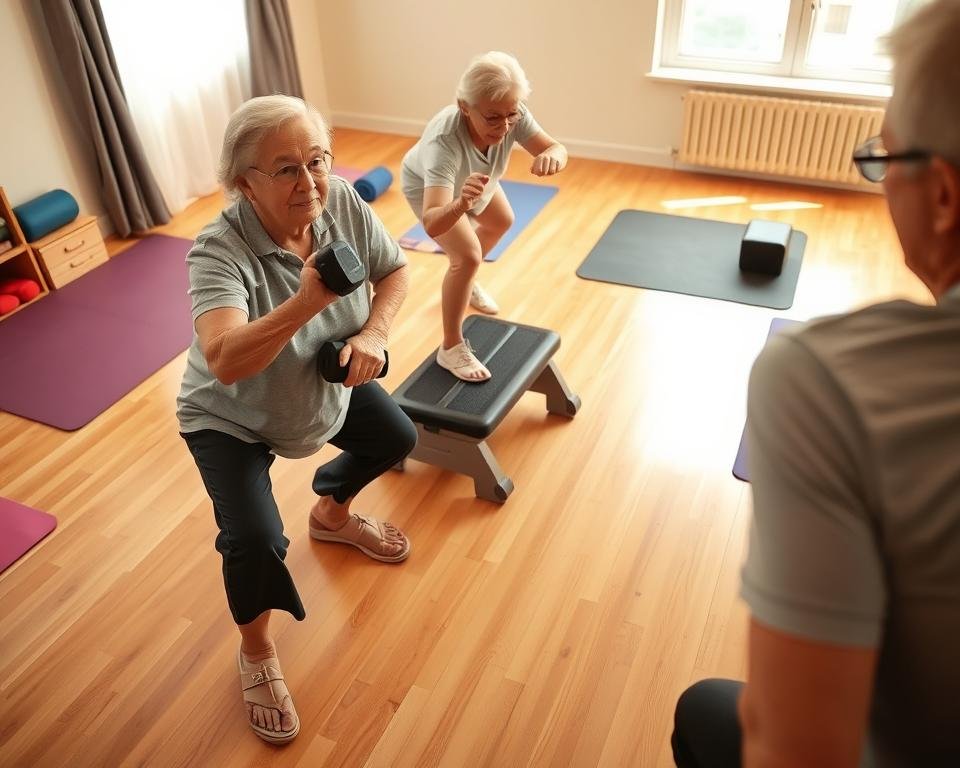“You can’t turn back the clock, but you can wind it up again.” – Helen Hayes. These words remind us that while aging is inevitable, taking charge of your bone health can help you stay active and resilient. This article will guide you through practical steps to protect your strength and mobility, no matter your age.
Your bones are the foundation of your body, and keeping them strong is essential for living life on your terms. Over time, factors like reduced bone density and natural wear can increase risk of fractures. But here’s the good news: simple daily choices—like staying active or prioritizing calcium-rich foods—can make a meaningful difference.
We’ll explore how weight-bearing movements, balanced nutrition, and proactive screenings work together to slow bone loss. You’ll also learn when medications might complement these efforts. Most importantly, you’ll discover how small changes today can help you maintain independence and enjoy the activities you love for years to come.
Key Takeaways
- Understanding bone health helps you reduce fracture risks as you age.
- Weight-bearing exercise and proper nutrition are critical for maintaining strength.
- Early action slows bone density decline more effectively than delayed treatment.
- Regular check-ups with your doctor help tailor strategies to your needs.
- Lifestyle adjustments today support long-term mobility and independence.
Understanding Osteoporosis and Its Impact
Imagine your bones as a honeycomb structure—strong yet porous. When bone density declines, those tiny spaces grow larger, leaving bones fragile. This condition often progresses without warning, making early action crucial to protect your mobility.
How Bone Strength Changes Over Time
Your bones naturally lose mass as you age, especially after 50. Women face higher risk due to menopause-related hormonal shifts, but men aren’t immune. Without enough density, even minor stumbles can lead to fractures in hips, wrists, or spine.
Why Silent Progression Matters
Unlike a sprained ankle or bruise, bone loss doesn’t cause pain until something breaks. Regular screenings, like DEXA scans, help spot changes early. Your doctor can then suggest strategies—whether nutrition tweaks or medications like bisphosphonates—to slow decline.
Weight-bearing activities, such as walking or light resistance training, stimulate bone renewal. Pair these with calcium-rich foods and vitamin D for better results. Remember: knowing your bone health status lets you take charge before small issues become big setbacks.
Osteoporosis Prevention and Treatment for Seniors: Best Practices Guide
Think of your skeleton as a living bank account—every deposit of calcium and movement builds interest in your future mobility. Acting before issues arise gives you the best chance to maintain strength and flexibility. “It’s easier to preserve bone mass than to regain it,” notes a Johns Hopkins study, highlighting why proactive care matters.

The Importance of Early Prevention
Starting healthy habits in your 50s or earlier helps slow bone decline significantly. Weight-bearing activities like dancing or stair-climbing stimulate cells to reinforce your frame. Pair these with vitamin D-rich foods to boost mineral absorption.
Simple swaps—chopping vegetables instead of chips or taking walking calls—add up over years. Research shows adults who prioritize lifestyle changes before significant bone loss cut fracture risks by up to 52%.
How Regular Evaluation Helps Manage Risks
DEXA scans act like financial audits for your bone density, revealing hidden weaknesses. Most experts recommend baseline testing at 65, or earlier if you’ve had fractures. Your doctor uses these results to create a personalized plan.
Follow-up tests every 2-5 years track progress, letting you adjust habits as needed. Early detection of low bone density allows interventions—like targeted exercises or dietary tweaks—to help prevent irreversible damage.
Effective Exercise and Lifestyle Changes
Your daily movements are like deposits in a bone health savings account—each step adds interest to your future mobility. Simple shifts in how you move can slow bone loss while building stability. Let’s explore how to turn ordinary activities into opportunities for stronger bones.

Weightbearing and Balance Exercises
Gravity is your ally when it comes to bone strength. Activities like brisk walking or stair-climbing force your body to work against resistance, sparking cells to reinforce bone density. Even low-impact options—Tai Chi or gentle yoga—improve coordination, cutting fall risk by up to 47% in older adults.
Try blending these into your week:
- Hiking on uneven terrain to challenge balance
- Heel-to-toe walks (like a tightrope) for stability
- Chair squats to build leg strength safely
Incorporating Movement into Your Daily Routine
You don’t need a gym membership to protect your bones. Dance while cooking, take “walking meetings,” or garden for 20 minutes. Studies show adults who add 30 minutes of daily movement help prevent fractures better than those relying solely on osteoporosis prevention strategies.
Start small: park farther from store entrances or do calf raises while brushing teeth. Over years, these habits preserve mobility by maintaining bone mass. Pair them with calcium-rich meals for a full-body approach to health.
Nutritional Strategies for Strong Bones
Your kitchen holds powerful tools to reinforce your frame from the inside out. Just as exercise strengthens muscles, the right foods act like construction crews repairing and fortifying your skeleton. Pairing smart eating habits with movement creates a winning combo against bone loss.

Building Blocks: Calcium and Vitamin D
Calcium acts as cement for your bones, while vitamin D ensures your body can use it effectively. Adults over 50 need 1,200 mg of calcium daily—equivalent to three cups of fortified almond milk. Vitamin D needs jump to 800-1,000 IU with age, especially for those getting limited sunlight.
Top food sources include:
- Yogurt (415 mg per cup)
- Collard greens (268 mg per cooked cup)
- Fortified orange juice (350 mg per glass)
Beyond the Basics: Nutrient-Rich Choices
Magnesium and vitamin K2 play supporting roles in bone renewal. Sprinkle pumpkin seeds on oatmeal or try fermented foods like natto. For easy lifestyle changes, swap soda for mineral water or add sardines to salads twice weekly.
Planning balanced meals becomes simpler with resources like nutrient-focused recipes. Your doctor can recommend supplements if dietary gaps persist, but whole foods offer better absorption. Remember: steady upgrades to your diet help maintain bone density as effectively as some medications.
Small tweaks—like adding chia seeds to smoothies—build up over years. These choices work alongside exercise to create bones that bend rather than break, keeping you active and resilient.
Medication Options and Professional Guidance
Think of prescription medications as specialized tools in your medical toolkit—each designed to address specific needs in maintaining skeletal strength. While diet and movement form the foundation of bone health, certain cases benefit from targeted therapy to reduce fracture risk. Let’s explore how these options work alongside your daily habits.
Understanding Prescription Medications
Common treatments like bisphosphonates slow natural bone loss by helping your body retain minerals. Other options, including selective estrogen modulators (SERMs), mimic hormones that protect density. Newer anabolic agents even help rebuild weakened areas over time.
Your doctor considers factors like age, gender, and test results when suggesting plans. For example:
- Postmenopausal women often benefit from hormone-related therapies
- Men with low testosterone might need different approaches
- Those with multiple risk factors may combine medications
When to Consult with Your Doctor
Always seek professional advice before starting new treatments. A diagnosis through DEXA scans reveals your bone density levels, guiding personalized decisions. Share your full medical history—conditions like kidney issues or past fractures influence choices.
Ask about:
- How long-term use might affect you
- Interactions with current supplements or alcohol
- Follow-up testing schedules
Remember: “Medications work best when paired with lifestyle changes,” says Dr. Emily Torres, a geriatric specialist. Regular check-ins let you adjust strategies as your health evolves, ensuring you stay strong and mobile.
Preventing Falls and Enhancing Your Home Safety
Your home should be your safest ally—not a hidden obstacle course. For those with lower bone density, even a stubbed toe can lead to life-changing injuries. Simple tweaks to your living space create a protective environment that lets you move confidently.
Smart Adjustments for Safer Spaces
Start by eliminating tripping hazards. Secure loose rugs with double-sided tape and keep walkways clutter-free. Install grab bars near toilets and showers—they’re sturdier than towel racks and can support your full weight if you slip.
Lighting upgrades make a big difference. Nightlights in hallways and motion-sensor lamps help you navigate safely after dark. “Most falls happen during routine activities,” explains physical therapist Mara Linwood. Rearrange frequently used items to waist-level shelves to avoid risky reaching.”
Pair these changes with balance-boosting activities. Tai Chi’s slow movements improve stability, while heel-toe walking drills sharpen coordination. Even standing on one leg while brushing teeth strengthens core muscles that reduce risk.
Review medications with your doctor—some prescriptions cause dizziness or drowsiness. A professional home safety assessment can spot overlooked dangers like loose handrails or slippery porch steps. These steps protect not just your health, but your independence and way of life.
Conclusion
Your skeletal system is like a well-built house—each beam and joint working together to keep you upright. By focusing on bone density through smart choices, you create lasting support for your active life. Early diagnosis, nutrient-rich meals, and tailored exercise all play vital roles in maintaining strength.
Working with your doctor helps identify risks before they escalate. Simple changes—like swapping soda for mineral water or adding balance exercises—add up over time. Even small adjustments to your home environment can dramatically reduce fall hazards.
Remember: medications like bisphosphonates work best when paired with daily movement and proper nutrition. If you smoke or drink alcohol regularly, consider gradual cuts to protect your frame. Every step toward better habits strengthens your body’s natural architecture.
You hold the tools to shape your bone health story. Start today by scheduling a check-up or trying one new strength-building recipe. Your future self will thank you for the independence and confidence that comes with resilient bones.
